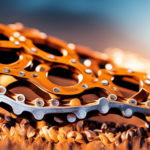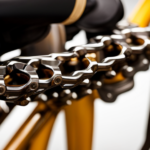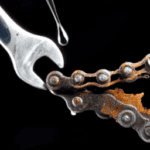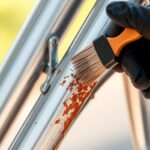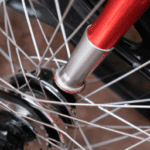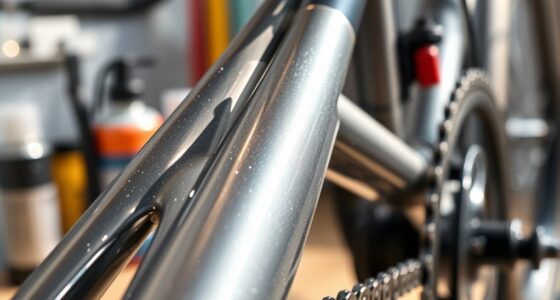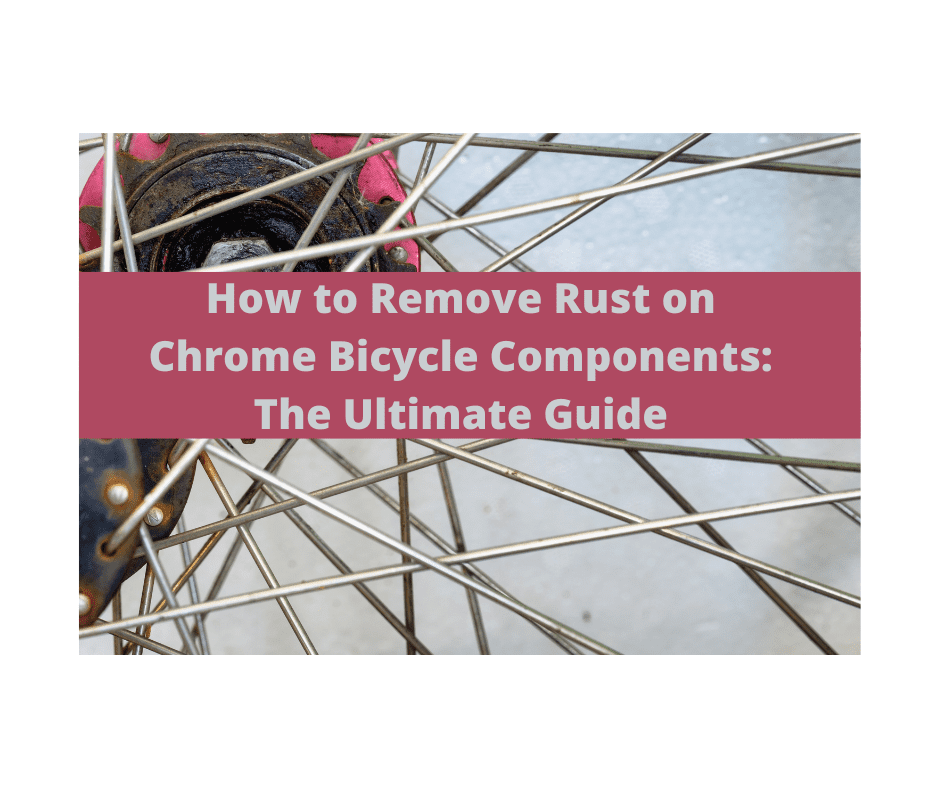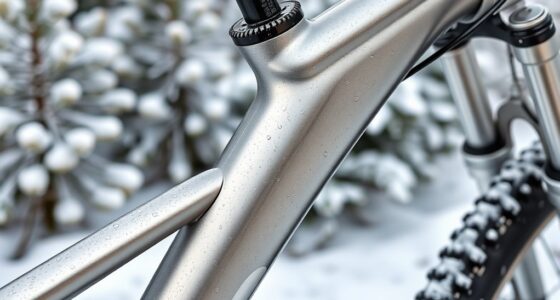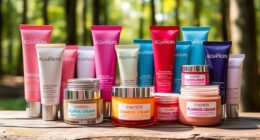To safely remove rust from bike components, start by cleaning the areas thoroughly with soap and water. Use gentle methods like soaking parts in vinegar or applying a baking soda paste to dissolve rust without damaging your bike’s finish. Rubbing with aluminum foil soaked in vinegar can also help lift rust gently. Afterward, rinse, dry completely, and protect surfaces with polish or a coating. For more tips on preserving your bike, keep exploring these safe rust removal techniques.
Key Takeaways
- Thoroughly clean the bike with soap and water before rust removal to prevent dirt from causing further corrosion.
- Use natural methods like vinegar or baking soda to dissolve rust safely, avoiding harsh chemicals.
- Wear protective gloves, goggles, and a mask during cleaning and chemical application to ensure personal safety.
- Rinse components thoroughly with water and dry completely to prevent moisture from causing new rust.
- Apply protective coatings or waxes after cleaning to shield surfaces from future rust formation.
Understanding the Causes of Rust on Bikes

Rust on bikes mainly occurs when moisture and oxygen come into contact with iron and steel parts, causing them to oxidize. This process, known as oxidation, leads to rust, which weakens the metal over time. Exposure to humidity, rain, and ambient moisture accelerates rust formation, especially if your bike is left outside or stored in damp conditions. Living near coastal areas increases the risk because salty sea air speeds up corrosion. Dirt, mud, and surface water trap moisture against your bike’s steel components, promoting rust development. Neglecting regular maintenance or proper storage worsens the problem. Understanding these factors helps you recognize why rust forms and emphasizes the importance of controlling moisture exposure to protect your bike’s metal parts from corrosion. Regular inspections and home furnishings maintenance can help prevent rust from progressing. Additionally, using protective coatings or rust inhibitors can create a barrier against moisture and slow down the oxidation process. Employing preventive measures such as applying wax or oil can further shield your bike from environmental elements that cause rust. Implementing adequate storage solutions, such as covered or indoor storage, further reduces exposure to moisture and prolongs the lifespan of your bike components.
Preparing Your Bike for Rust Removal
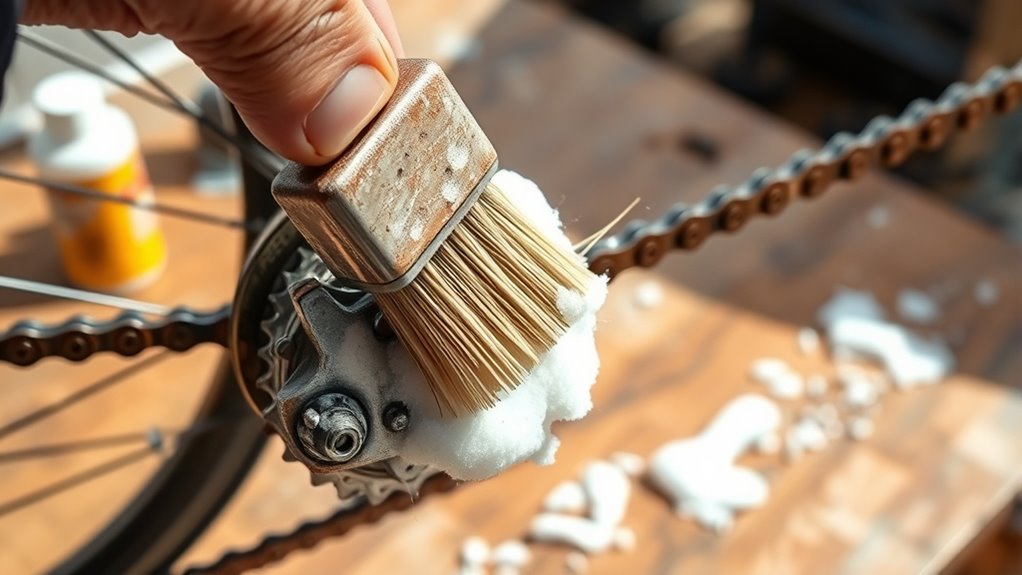
Before you start removing rust, it’s important to prepare your bike properly. Begin by thoroughly cleaning the bike with soap and water to remove dirt, grease, and grime, which helps the rust removal process work more effectively. Use a camera or smartphone to photograph decals, stickers, and key components so you can restore your bike’s original look later. Disassemble the bike by removing wheels, chains, and accessories, and keep bolts and nuts organized for easy reassembly. Carefully inspect the frame for any signs of structural damage or weak welds that might need extra repair before rust removal. Additionally, consider water-based cleaning methods to ensure a gentle yet effective cleaning process. This approach can also prevent trust issues from developing during the cleaning process. Furthermore, using appropriate cleaning agents can enhance the overall cleaning effectiveness and prepare the surface better for rust treatment. To improve the effectiveness of rust removal, it’s also helpful to understand corrosion mechanisms, which can guide you in choosing the right products and techniques. Finally, give the entire frame and wheels a gentle power wash to loosen loose dirt and ensure a clean surface ready for rust treatment.
Natural Methods for Rust Elimination
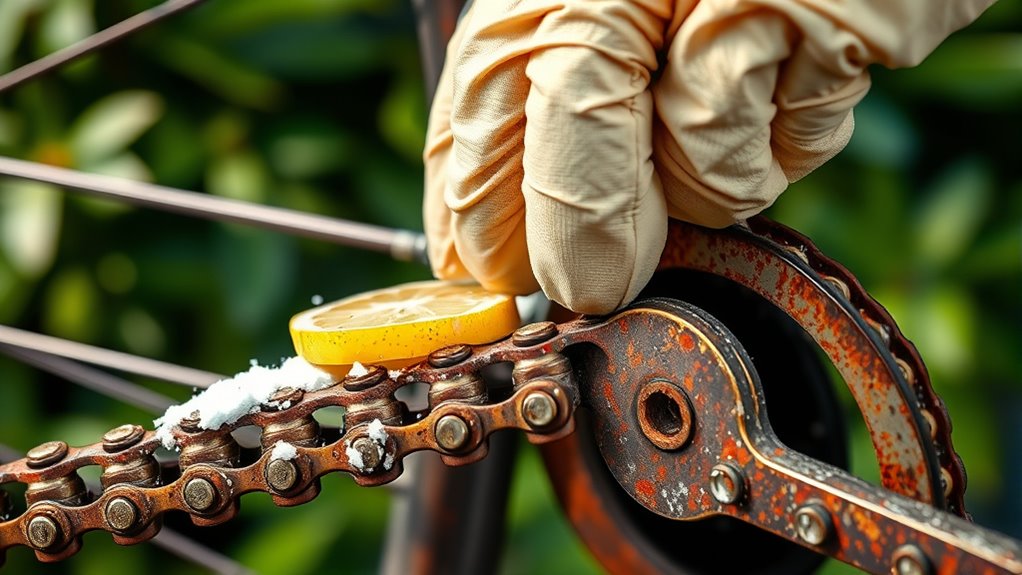
Natural solutions like vinegar and baking soda can effectively remove rust from your bike components without harsh chemicals. Vinegar dissolves surface rust when soaked, while baking soda’s mild abrasiveness helps lift rust when scrubbed on affected areas. Combining these natural ingredients creates eco-friendly methods that are safe and easy to use. Celebrating the bond between father and daughter can inspire patience and care during your cleaning process.
Vinegar’s Rust-Fighting Power
White vinegar, with its low pH of around 3, is an effective natural solution for removing surface rust from small bike components like nuts and screws. The acidity in vinegar helps loosen rust particles, making rust removal easier. Soaking rusty parts in vinegar for a few hours softens the surface rust, preparing it for easier scrubbing. After soaking, you can scrub the components with a brush or steel wool to remove remaining rust and restore the metal’s surface. Vinegar’s gentle acidity makes it safe for most painted or chrome bike parts when used carefully and rinsed thoroughly afterward. Its cost-effectiveness and minimal environmental impact make vinegar a popular choice for bike maintenance, especially for small parts needing safe, natural rust removal. Additionally, understanding the latest advancements in machine learning technology can help develop smarter, more efficient tools for rust detection and removal. Regular inspection and preventive maintenance can help avoid rust buildup in the future. Incorporating corrosion-resistant coatings can further protect your bike components from future rust formation. Moreover, using proper cleaning techniques can extend the lifespan of your bike parts and reduce the need for frequent rust removal.
Baking Soda’s Gentle Action
Baking soda is a gentle yet effective natural method for removing rust from bike components. When mixed with water to form a thick paste, it acts as a mild abrasive that lifts surface rust without damaging the metal. Applying this rust remover directly to affected areas and letting it sit for 10-15 minutes helps loosen oxidation, making rust removal easier. Gentle scrubbing with a toothbrush or soft cloth afterward can effectively eliminate surface rust while preserving your bike’s finish. Baking soda’s alkaline nature neutralizes rust’s acidity, slowing future corrosion when used regularly as part of maintenance. This natural cleaning solution is safe for most bike surfaces, including painted and chrome parts, but be sure to rinse thoroughly to prevent residue buildup. Additionally, regular use of corrosion prevention techniques can extend the lifespan of your bike components.
Combining Natural Solutions
Combining household items like vinegar, lemon juice, and olive oil offers an effective way to tackle rust without resorting to harsh chemicals. You can use vinegar as a natural rust remover by soaking small metal parts or applying it directly to rusted areas. Baking soda mixed with lemon juice creates a gentle paste perfect for scrubbing away rust while protecting your bike’s paint. Rubbing rusted spots with aluminum foil soaked in vinegar acts as a mild abrasive that lifts rust without damaging the metal. These natural solutions are simple, affordable, and safe. Regular use, along with thorough drying and maintenance, helps prevent rust from reappearing and extends the lifespan of your bike components. Incorporating rust prevention techniques like proper storage and regular cleaning can further enhance your efforts. Interestingly, recent AI discoveries have demonstrated the potential for innovative approaches to material preservation, which could influence future rust prevention strategies. Understanding the chemical reactions involved in rust removal can help you optimize your methods for better results. Additionally, understanding corrosion mechanisms can help you select the most effective natural solutions for your specific needs. Combining these methods ensures effective rust removal without harmful chemicals.
Using Chemical Rust Removers Safely
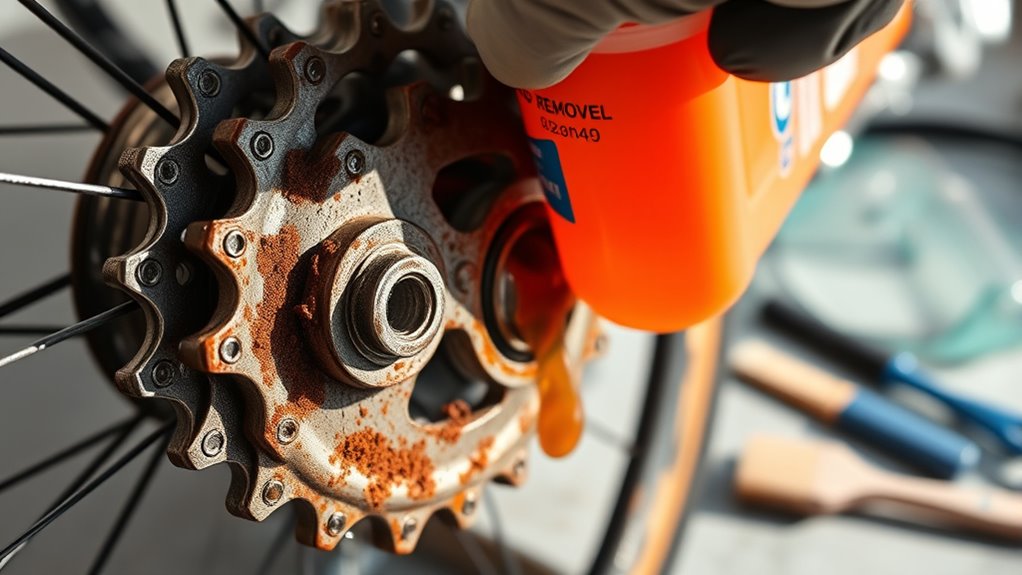
When using chemical rust removers on your bike components, it’s essential to prioritize safety to prevent injuries and damage. Always wear protective gloves, goggles, and a mask to shield your skin, eyes, and respiratory system from harmful fumes and splashes. Carefully follow the manufacturer instructions, including recommended application times and rinsing procedures, to avoid surface etching or damage. Work in a well-ventilated area or outdoors to reduce inhalation risks. Be cautious with harsh acids like hydrochloric acid, especially on painted or aluminum surfaces, to prevent corrosion. After use, guarantee proper disposal of chemical solutions according to local regulations. This approach protects both you and your bike components, ensuring safe and effective rust removal. Additionally, understanding chemical safety protocols can further minimize risks associated with using potent rust removers. Proper protective equipment usage is crucial to safeguard yourself during this process. Moreover, being aware of proper disposal procedures helps prevent environmental contamination and adheres to safety standards.
Post-Treatment Care and Surface Restoration
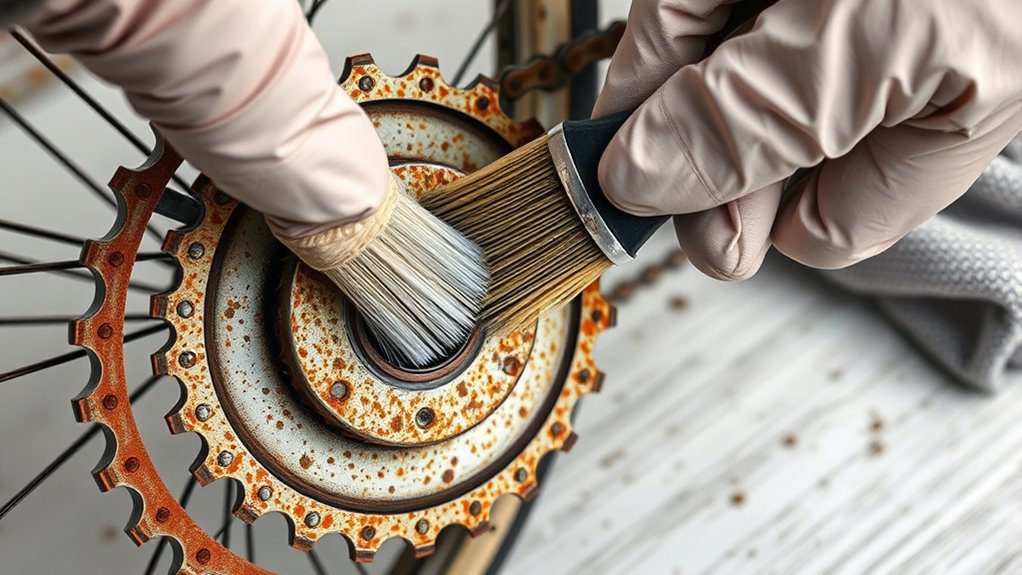
Once you’ve removed the rust, it’s essential to rinse the components thoroughly to wash away any leftover chemicals. Make sure to dry all surfaces completely to prevent moisture from causing new rust. Then, polishing and applying protective coatings will help restore the surface and keep rust at bay.
Rinse and Dry Thoroughly
After completing the rust removal process, it’s essential to rinse your bike components thoroughly with clean water to wash away any remaining cleaning agents or rust particles. This step ensures no residue is left that could cause further corrosion. Once rinsed, dry all surfaces completely using a soft cloth or compressed air to prevent moisture from lingering. Pay close attention to crevices and threaded areas where water can hide, as trapped moisture can accelerate rust re-formation. To enhance surface preservation, consider these tips:
- Carefully rinse all surfaces with water to remove debris and chemicals
- Use a soft cloth or compressed air to dry, especially in hard-to-reach spots
- Ensure no moisture remains on surfaces to prevent future rust development
Proper rinsing and drying are key to maintaining a rust-free, smooth surface.
Polish for Surface Smoothness
Polishing your bike’s surface after rust removal not only restores its smoothness but also enhances its overall appearance. Use a suitable polish—abrasive for rough areas or non-abrasive for delicate surfaces—to achieve the most favorable surface smoothness. Apply the polish evenly with a soft microfiber cloth or buffing pad, ensuring you avoid scratches. For chrome or painted surfaces, choose a polish designed specifically for those materials to deliver a high-gloss finish. Regular polishing helps maintain the smooth feel of your components, prolongs the lifespan of the finishes, and keeps your bike looking its best. After polishing, consider applying a protective coating or wax to create a barrier against moisture, which helps prevent future rust and preserves that sleek, smooth surface.
Apply Protective Coatings
Applying protective coatings is a vital step in maintaining your bike’s restored surface. After cleaning, confirm the surface is thoroughly dry and free of residue to maximize adhesion. The application process involves evenly spreading a protective coating such as clear enamel, a bike-specific sealant, or rust-inhibiting paint. For added protection, you can also apply a thin layer of wax or polish, which creates a moisture barrier to prevent future rust. Consider the following options for surface protection:
- Protective coating like clear enamel or sealant
- Rust-inhibiting paint for durable coverage
- Wax or polish to seal and add shine
Reapplying these coatings regularly maintains an effective barrier against moisture and environmental elements, prolonging your bike’s finish and preventing rust reformation.
Tips for Preventing Future Rust Buildup
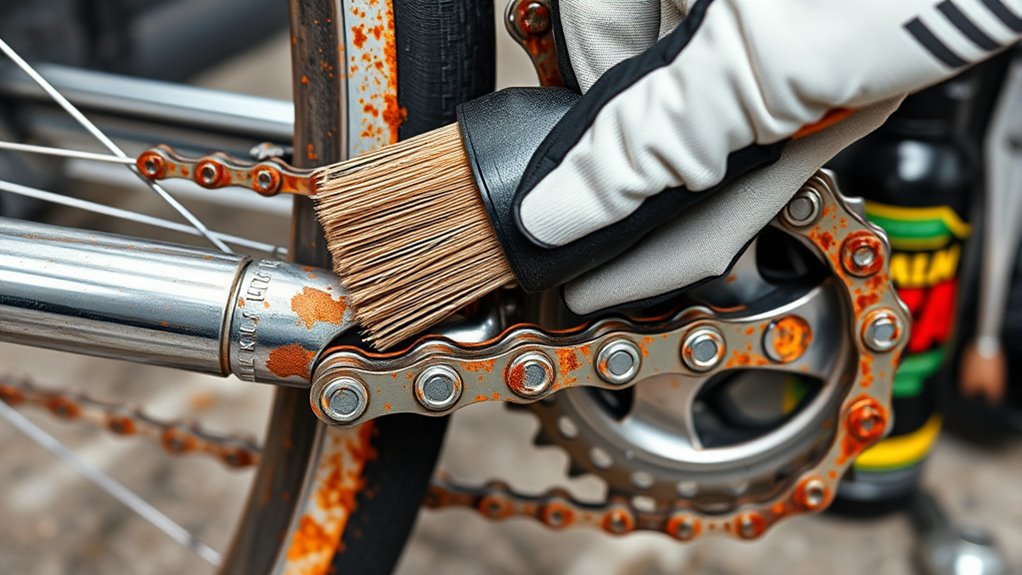
To prevent future rust buildup on your bike components, consistent maintenance is key. Regular cleaning removes dirt, salt, and debris that can accelerate corrosion, especially after riding on salted roads or near the coast. Applying a thin layer of lubricant like bike-specific oil or wax creates a protective barrier, preventing moisture and air from contacting metal surfaces. Protect your bike by storing it in a dry, sheltered environment such as an indoor garage or covered area, which considerably reduces rust risk. Additionally, inspecting and maintaining protective coatings like paint or clear sealants helps prevent surface damage that exposes metal to moisture. These maintenance tips work together to prevent corrosion and keep your bike in top condition, ensuring longevity and safe riding.
Frequently Asked Questions
How Do You Remove Rust From Bike Components?
To remove rust from bike components, start by gently scrubbing the rusted areas with fine steel wool or a soft brass brush. For small parts like nuts and bolts, soak them in white vinegar for several hours to dissolve rust. Afterward, rinse thoroughly, dry completely, and apply lubricant. Using rust converters or chemical removers can also help, but follow safety instructions carefully to keep yourself protected.
How Do You Remove Rust Without Damaging It?
Think of rust as that stubborn guest who refuses to leave your bike’s party. To remove it without damage, you gently scrub with fine steel wool or a soft brush, avoiding harsh abrasives. Apply rust removers carefully, rinse well, and dry thoroughly. Test first on hidden spots, then finish with a protective layer. This way, you keep your bike shining without turning it into a scrapyard relic.
How Do You Get Rust off a Bike Without Scratching It?
To get rust off your bike without scratching it, start by using soft materials like microfiber cloths, non-abrasive sponges, or aluminum foil. Gently scrub the rusted areas, applying rust removers or vinegar with a soft brush or cloth. Always test any cleaner first on a small spot. Rinse thoroughly, dry completely, and finish with a protective wax or polish to keep your bike looking great.
Does WD 40 Remove Rust on Bikes?
Yes, WD-40 can help remove rust from your bike. It works by penetrating rusted surfaces and loosening the corrosion, making it easier to wipe away or scrub off. However, keep in mind that WD-40 is mainly a water-displacing spray, not a dedicated rust remover. For heavy rust, you might need specialized products or mechanical methods, but WD-40 is a good start for light surface rust.
Conclusion
So, now that you know how to banish rust, your bike can shine brighter than a disco ball at midnight. Just remember, rust’s only victory is convincing you it’s inevitable—like taxes or bad coffee. With these tips, you’re basically a rust-removal ninja, ready to defy nature’s little corrosion prank. Keep up the effort, and someday, your bike might even forget it was ever rusty. Or at least, look like it did—without the actual rust.


